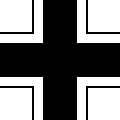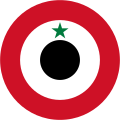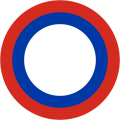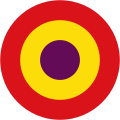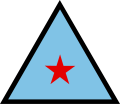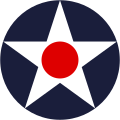Roundel

A roundel in heraldry is any circular shape; in military use it is an emblem of nationality employed on military aircraft and air force flags, generally round and consisting of concentric rings of different colors.
Heraldry
In heraldry, a roundel is a circular charge. Roundels are among the oldest charges used in coats of arms, dating from at least the twelfth century. Roundels in British heraldry have different names depending on their tincture.[1] Thus, while a roundel may be blazoned by its tincture, e.g., a roundel vert (literally "a roundel green"), it is more often described by a single word, in this case pomme (literally "apple", from the French).
| metals | colours | neutral | |||||
|---|---|---|---|---|---|---|---|
bezant coin |
plate silver |
hurt berry |
torteau cake |
pellet gunshot |
pomme apple |
golpe wound |
fountain fountain |
In French blazon, a roundel of either metal (or or argent) is a besant, and a roundel of any colour (dark tincture) is a torteau, with the tincture specified.
One special example of a named roundel is the fountain. This is depicted as a roundel barry wavy argent and azure. That is, it is not filled in a single tincture, but with alternating horizontal wavy bands of blue and silver (or white). Because the fountain consists equally of parts in a light and a dark tincture, its use is not limited by the rule of tincture as are the other roundels.

In their earliest uses, roundels were often strewn (semy) upon the field of a coat of arms, a design with as many names as there are tinctures. For example, a field semy of roundels argent could be called platy; a field semy of roundels sable could be called pellety. The precise number and placement of the roundels in such cases were usually left to the discretion of the artist.
Because of their long use and simple outline, roundels are accorded status as a subordinary charge by most heraldic writers.
The term roundel also describes a circular shield used for heraldic display (as opposed to other forms such as the more common escutcheon or lozenge). An example of arms borne on a roundel is the Coat of Arms of Nunavut.
Use on military aircraft

The first use of a roundel on military aircraft was during the First World War by the French Air Service[citation needed]. The chosen design was the French national cockade, which consisted of a blue-white-red emblem mirroring the colours of the Flag of France. Similar national cockades were designed and adopted for use as aircraft roundels by their allies. The British Royal Flying Corps (RFC) abandoned their original painted Union Flags because they looked too much like the German cross and the British soldiers in the trenches had shot at them mistaking them for German aircraft. Instead, British aircraft roundels were eventually designed to use the French colours in reverse, red-white-blue from center to rim, after a short period of using a red-rimmed white circle that closely resembled the roundel, used to this day by Denmark. This red-white-blue from center to rim roundel design was subsequently adopted by British Imperial air forces with a maple leaf (RCAF), kangaroo (RAAF), and kiwi (RNZAF). During WWI, roundels based on national cockade colours were subsequently adopted by the air forces of other countries, including the U.S. Army Air Service.
The military aviation insignia of both the United States and Russia have had interesting "crossovers" early in the 20th century. The initial US Army Air Service insignia, used during the Pancho Villa punitive expedition just before World War I, used on the vertical tail and wings (as seen on early Curtiss biplane two-seat observation aircraft), was essentially the red star of the slightly later Soviet Union, without a red or white outline border. The Imperial Russian tricolor roundel was also adopted by the US Army Air Service, in more evenly spaced proportions than the Tsarist marking, in World War I air combat in Europe, because the then-recently adopted "star-in-circle" insignia could possibly be mistaken for a German or Austro-Hungarian "Eisernes Kreuz" (iron cross) insignia at some distance. The US roundel added a pair of white bars during World War II, becoming the famous "Stars and Bars" insignia, a red bar bisecting the white was added in 1947 when the United States Air Force became a separate service.
During the Second World War, the red inner circle of RAF-based roundels on planes based in the Asia-Pacific was painted white or light blue, so they would not be confused for the Hinomaru red circle on Japanese planes, still used by the self-defense forces of Japan to this day.

In recent decades, "low-visibility" roundels have been used, especially on active combat types. Low-visibility roundels usually have subdued, low-contrast colors or stenciled outlines.
In pop culture
- The roundel, especially the RAF's, has been associated with British pop art of the 1960s, appearing in paintings by Jasper Johns. It became part of the pop consciousness after British rock group The Who started to wear RAF roundels (and Union Flags) as part of their stage apparel at the start of their career. Subsequently it came to symbolise Mods and the Mod Revival.
- Some of Paul Weller's material involves the use of a roundel in psychedelic colours.
- Ben Harper's album Fight For Your Mind uses roundels from several nation's air forces as graphics in the liner notes.
- In the British television series Doctor Who, the circular decorations on the interior walls of the TARDIS control room are known as roundels.
Roundels of national air forces
-
Australia (low visibility) -
Canada (low visibility) -
France (naval) -
Portugal (low visibility) -
United Kingdom
(low visibility)
Roundels of former national air forces
For roundels of other former air forces go to List of air forces.
-
United Arab Republic (Egypt and Syria) -
U.S. Army Air Corps (1926-1941)
Corporate Usage
Some corporations and other organizations also make use of roundels in their branding; employing them as a trademark, or logo.
Examples include:
See also
- List of air forces (contains more examples)
- Cockade
- Tincture (heraldry)
- Bezant
- Goutte
- Aircraft recognition
References
- ^ Fox-Davies, Arthur Charles (1909). A Complete Guide to Heraldry. p. 151.
- ^ http://www.ilmavoimat.fi/index_en.php?id=624
- Smith, Whitney (1975). Flags:Through The Ages And Around The World. McGraw Hill. pp. 24, 342. doi:JC345.S57. ISBN 0070590931.
{{cite book}}: Check|doi=value (help)
External links
- Roundels of the World for a more complete gallery.
- Canadian Military Aircraft Roundels has a section on the history of roundels.
- History of the RAF roundel
- Russian and Soviet aircraft simbols


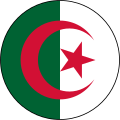





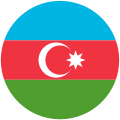










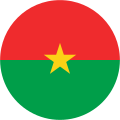



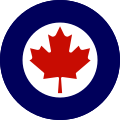



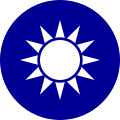
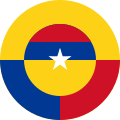



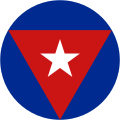





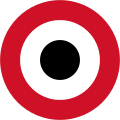



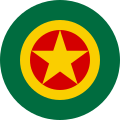

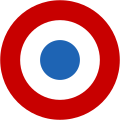


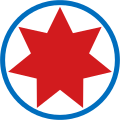



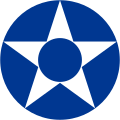





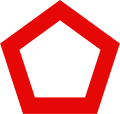


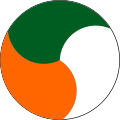






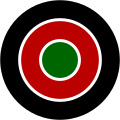
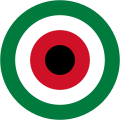


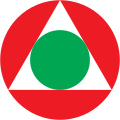


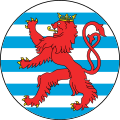
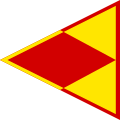





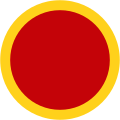

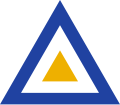





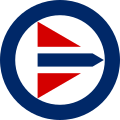










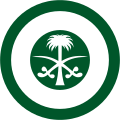







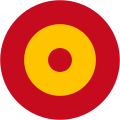


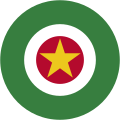

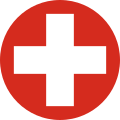



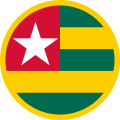











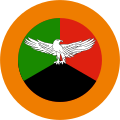
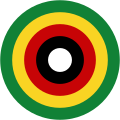



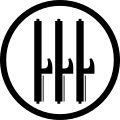
![Finland 1918–1945[2]](http://upload.wikimedia.org/wikipedia/commons/thumb/c/c0/Finnish_air_force_roundel_1934-1945_border.svg/120px-Finnish_air_force_roundel_1934-1945_border.svg.png)

